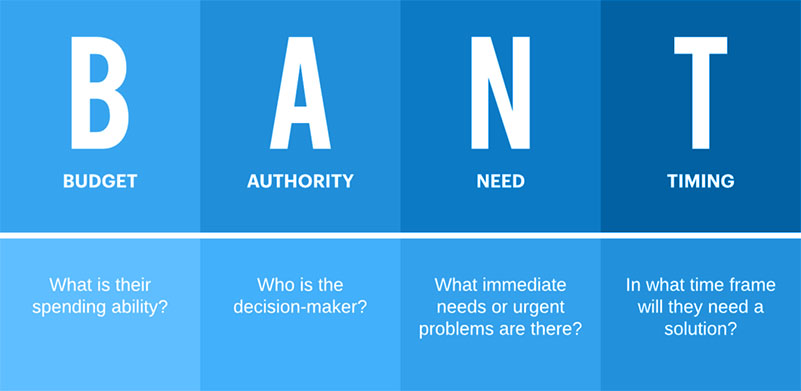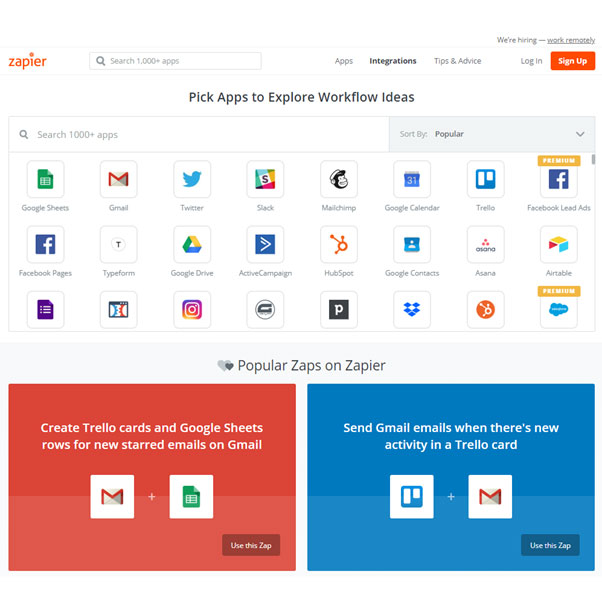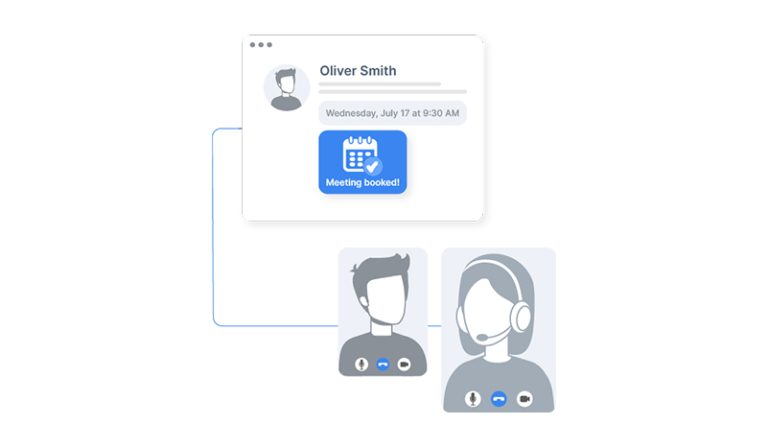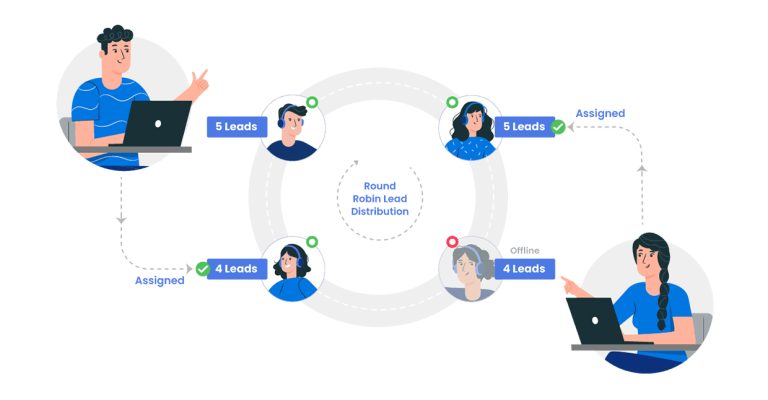Lead qualification can be a daunting task for any sales rep.
Whilst we have available, powerful tools for inbound marketing that can do some of the heavy lifting for us, it may appear that there is an easy way out.
However, sometimes, the information given by prospects does not fully reflect their intent or needs. This is where the BANT Methodology comes into play!
If done correctly, the BANT criteria can prevent mistakes from happening down the line in your sales cycle.
This lead qualification framework ensures the structure of information gathering covers most of the areas necessary, to equip you with the information you need to successfully close a deal.
What Is BANT?
So what does BANT stand for? Well, IBM has been a pioneer in lead qualification since they invented it in the 1950’s. The BANT sales methodology stands for, budget, authority, need, and timeline. This simple yet effective system is still used as part of the Business Agility Solution Identification Guide, to help qualify and prioritise leads for maximum success!
Before beginning the sales process with leads, it’s imperative to determine whether they’re qualified, this is where having an established framework like the BANT criteria comes into effect.
Let’s walk through each part of the BANT sales methodology:
- Budget: Before taking the next step with a lead, be sure to assess if they have the budget allocated for your solution.
- Authority: Ascertain whether your lead possesses the necessary power to make a decision and provide approval for their purchase.
- Need: Uncover the problem that your solution can address and understand how it is affecting the customer’s profitability or business processes.
- Timeline: Evaluate if the necessity of your solution is urgent or not — what’s pushing the timeline?
If you meet at least three of BANT criteria, then typically, a team will consider them “sales qualified,” — but this can differ from organisation to organisation. Asking relevant questions upfront and being decisive about qualification status makes all the difference in a successful sale!

BANT criteria qualifying questions
When working with prospects, it’s important to have a conversation rather than just fire off questions that may come across in the wrong way.
Ask BANT sales methodology questions in different orders or mix up the phrasing to make it as conversational as possible – after all, we’re not robots, we’re all human!
To maximise the effectiveness of your BANT sales method, try out some of these engaging and probing questions, designed to extract as much information as possible from the BANT criteria.
Budget
Do you have a budget allocated specifically for the type of product (or service) that we offer?
It’s important to be aware of any budget constraints the prospect may have, as this will help you determine whether or not your solution is feasible. Knowing the budget range ahead of time can also help save time by avoiding conversations with prospects who cannot afford your product.
This is one of the most important question in the BANT sales methodology, as it will dictate what product or service you pitch to the prospect.
What kind of return on investment are you aiming to achieve?
By posing this question, you can position your product to fully satisfy the prospect’s revenue goals.
This can be a game changing question within your BANT criteria, by understanding what part of the return on investment, the product or service will contribute.
Authority
Is there anyone else who needs to approve this decision?
It is important to ask if any other individuals are included in this buying decisions process, as their input may be essential for a final decision.
So you don’t have to repeat yourself, and to remove the back and forth, did you want to invite anyone else to the call?
It’s important to make sure all parties are present when discussing the decision. Having the right stakeholders in attendance will ensure that everyone has a thorough understanding of the project and that their input is taken into account.
In regards to our product, which people in the business will be using it?
Even if you are not able to pinpoint the ultimate decision-maker, research will reveal who else may be playing a role in making this purchase.
Need
What have you tried in the past to address these challenges?
This question allows you to understand which solutions the prospect has already explored and how satisfied they were with their results. It also gives them an opportunity to share what specific strategies or products they’ve used and whether it was successful or not.
How does solving this problem benefit your team/organisation?
This question allows you to understand the real value that addressing this problem would bring to the prospect. It also encourages them to think about how much it could save them in terms of time, resources and money if they find a successful solution.
If this issue was solved, what does success look like?
At its core, the BANT methodology has to be aligned towards what the prospect is trying to achieve, with some form of measurable result. This question helps you assess the goals and expectations of the prospect. It can also help you build a solution tailored to their specific needs and objectives, so they can achieve success quickly and efficiently.
What resources do you have available to tackle this problem?
This question allows you to determine if the prospect has the necessary resources to be successful with your solution. It also helps you assess whether they have the capacity to invest in additional resources or training that may be needed to ensure success.
Timeline
Is there a specific timeline or event you need to have this problem resolved by?
Urgency doesn’t always have to be created by you as a salesperson; sometimes it can result from an internal deadline that both parties need to meet.
What does your ideal revenue goal look like for next month?
This can be a direct goal, such as increasing revenue or lead generation, or an indirect one, such as reducing customer churn. Having a clear idea of what success looks like will help shape a strategy and plan for implementing the solution.
When making sure these prospects become BANT qualified leads, interconnecting goals to revenue will allow you to understand the product’s value within their internal tech stack.
Are there any key requirements within the solution you are looking for?
Knowing the key requirements can uncover unforeseen potential obstacles which you may not be aware of and enable you to plan how to overcome these obstacles quickly.
When undertaking, how to define BANT, uncovering obstacles which aren’t obvious is where the Need and Timeline part of the acronym meet, as it is these obstacles which will hold both parties back from achieving their respective goals.

How to Use BANT to Qualify Leads?
The stale BANT sales method is no longer sufficient for success in today’s competitive market.
An essential component of the sales process is assisting leads in creating a strong business case for your solution, then finding the budget internally to pay for it.
A successful approach today needs more relatability, but don’t worry— we are going to walk you through using the BANT sales methodology for success, regardless of your resources.
Look Beyond The Budget
The old-school approach of relying solely on a budget to qualify a lead may no longer be enough, as solutions become more complex, the BANT criteria evolves with sales cycles having more stages.
In today’s world, you need to dig deeper and understand the customer’s needs and how your product or service can address their pain points.
It is only after understanding the prospects problems that the budget should come into the conversation. Understanding how the customer plans to pay for your product or service, whether it’s coming from one department’s budget or two will be key to setting up the deal to close within a quick time frame.
Answering these questions can give you more insight into the prospects decision-making process and help you tailor your pitch accordingly.
Meet with the decision-makers
In today’s world, particularly when it comes to B2B sales, decisions are not frequently made by one individual. Rather, the process involves multiple people and a collective input for successful outcomes. To aid in this endeavor, we suggest mapping out everyone involved. Take note of their job titles and roles in making the decision along with what matters most to them as well as how you can gain access throughout your journey.
With an expanding contact list, you will have greater authority and be better able to hold onto any potential sales opportunities. Don’t let this chance slip away!
Recognize the Importance of The Problem
To effectively address this issue for your prospects, you must gain comprehensive insight into its effects on their business.
Being aware of any potential misalignments between a lead’s needs and an executive team’s priorities is essential in order to keep the sales process running smoothly. Acknowledge and address these issues without delay!
Uncover the needs of your lead, their team, and their leaders to ensure that you provide the best possible solutions.
As you are now a BANT methodology expert, this can be uncovered through this process.
Establish a Timeline For The Purchase Process
To effectively address this issue for your prospects, you must gain comprehensive insight into its effects on their business.
Being aware of any potential misalignments between a lead’s needs
To make sure you’re prepared to close the deal, understand in detail your prospect’s purchase process.
Using the BANT criteria to get a detailed understanding of your prospects’ purchase journey will allow you to plan backward and make the closing process more successful. By comprehending each step involved in their buying decision, you can shape an effective pipeline that guides them toward making a purchase.
Additionally, it’s beneficial to determine early on if the project will require a simple pitch or several months of approval processes and will also accelerate your own BANT sales methodology by making your process more efficient.
How to Use the BANT Sales Framework and Process
How Not To Use the BANT sales method
Despite being an older framework, the BANT sales methodology can still be beneficial when used correctly. It doesn’t matter what order you ask the questions in; all of the data acquired is incredibly useful. But it falls short if sales reps treat it like a to-do list, ticking off each item as they go along without really considering how their answers could inform their strategy moving forward.
In other words, if used without thoughtfulness beyond memorised questions, then BANT isn’t likely going to provide invaluable insight – which is what everyone wants!
Conversations should be more than just a one-way interrogation! The BANT sales method is meant to provide structured guidance, not create barriers.
Qualifying prospects based on all four characteristics is essential, though the order in which you do it isn’t set; seize any chance to delve further if one becomes available. Orchestrate the process for each individual lead with personalization so that it’s more effective.
Alternatives to BANT
The Bottom Line
The BANT criteria has withstood the test of time, proving it to be a strong and noteworthy tool for sales teams.
If you haven’t used BANT before or think that it’s outdated, try putting its framework into practice on your next call!
With the right approach and conversation techniques that build on this framework, you’ll gain a wealth of knowledge about your prospects – likely more than expected!
The old adage rings true here: don’t just scratch the surface; take time to delve deep into their needs and understand the positive benefit can have on their whole organisation.
Take your BANT sales methodology step further and develop it into something unique to you. Incorporate more open ended questions that will empower you to validate your leads problems better and close even bigger deals!










